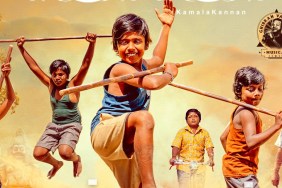
I believe there’s a hint as to what we’re supposed to take out of Werner Herzog introduces Cobra Verde in the speed with which he introduces the film’s central character, Francisco Manoel da Silva (Klaus Kinski), a ruined Brazilian rancher-turned-bandit who eventually finds himself at the center of the slave trade between Africa and South America. We never get to know Francisco the rancher, instead we first see him rumbling down a muddy hill, where he works for a gold mining company, and has just learned his wages have gone straight to the bank. That night he kills his boss, the scene cuts to black, next we meet the man Francisco has become, the feared bandit known as Cobra Verde (Green Snake).
Cold, fearless and without sympathy, da Silva’s travels eventually find him in the favor of Don Octávio Coutinho (José Lewgoy), who hires da Silva to oversea his sugar plantations without realizing just whom exactly he was. When all three of Octavio’s daughters come up pregnant. Octavio, along with other local aristocrats, search for a way to rid themselves of da Silva without killing him, which leads to the offer sending da Silva to Western Africa to re-open the slave trade, a journey all, including da Silva, realize will likely end in his death, but he accepts nonetheless.
Once he arrives, da Silva is forced to negotiate, and eventually succeeds, with King Bossa Ahadee of Dahomey (played by Nana Agyefi Kwame II and credited as His Royal Highness Nana Agyefi Kwame II of Nsein). Da Silva’s success is unexpected by both he and those that sent him, but the success is short-lived as conflicts and misunderstandings arise to the point da Silva finds it may be his head on the chopping block.
There’s a level of madness to just about every character in Cobra Verde, but, I think, the least of which is da Silva himself. Da Silva I find to be more of a “survivor by any means” than he is insane or even close to madness.
By the film’s end, it may surprise some to see the level of understanding with which he recognizes his own villainy and the evil of which he was involved. Slavery has been outlawed, the English have put a price on his head and while sharing a bottle of champagne with Captain Pedro Vicente (Benito Stefanelli), Vicente says, “To slavery… the greatest misunderstanding of mankind.” Da Silva responds, “It was no misunderstaning. It was a crime. Slavery is an element of the human heart… To our ruin!”
I’ve seen other reviews of Cobra Verde say the film is lacking in narrative, is confusing and they find it difficult to understand the point of it all. Perhaps I’m way off base, but the quotes above appear to spell out exactly the motivations behind the film, and particularly behind Kinski’s character, a man that recognizes he’s evil and the evil within his heart and yet he acts as he does because it’s the only way he knows how to survive.
As I already said, we never see da Silva as a rancher and when we’re first introduced to him he’s muddy from work, and eventually driven to murder. Are we to assume he was always evil or that he’s the ruined product of his environment and circumstance? If you’re looking for a point to Cobra Verde the age old saying, “evil begets evil” seems apt enough.
Cobra Verde marks the fifth time Herzog and Kinski worked together and it would also be the last time. It’s the film that brought us the most iconic photo of the director and star working together and apparently things got so bad original cinematographer Thomas Mauch quit in the middle of production and had to be replaced by Viktor Ruzicka. Trouble continued to plague the film as it’s domestic distributor declared bankruptcy before it was released. It wouldn’t be until 2007, twenty years later, that the film would find its way to U.S. theaters.
Like all of Herzog’s films it has a distinct visual style, and Kinski is absolutely stunning in the lead role, giving his absolute all. As much as the stories from Herzog’s productions with Kinski always bend toward discussing Kinski’s antics on set, I can’t help but think the kind of characters Kinski was playing had something, if not everything, to do with the way he behaved. The stories don’t seem to be the same on Woyzeck and Nosferatu, but when it comes to the torturous productions of Aguirre, Fitzcarraldo and Cobra Verde it makes total sense, and boy does it add to the overall cinematic value.
Few actors seem to “give” on the same level as Kinski and Herzog seemed to get the absolute best out of him every time out and Cobra Verde finds him in a role as intense as it is quietly restrained. Kinski seemed to live on a razor’s edge and he brought that same level of fascination to his characters and the films he was in are all the better for it.


![]Longlegs Trailer Shows Intense Search for Serial Killer in Neon Horror Movie](https://www.comingsoon.net/wp-content/uploads/sites/3/2024/05/longlegs-still.png?w=182&h=122&crop=1)






